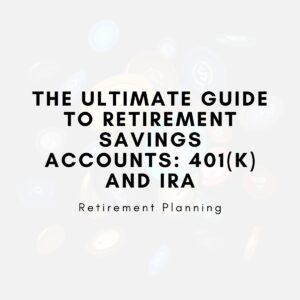
How can you catch up on your retirement savings in your 40s and 50s?
If you’re starting to worry about your retirement savings as you approach your 40s and 50s, there are actionable strategies you can take. It’s not too late to boost your retirement fund. By maximizing retirement accounts, cutting unnecessary expenses, and making smart investment choices, you can make up for lost time and secure a comfortable retirement.
Summary Table: How to Catch Up on Retirement Savings in Your 40s and 50s?
| Section | Summary | Key Tips | Examples |
|---|---|---|---|
| Understanding the Need to Catch Up | The importance of assessing your current retirement savings gap and understanding why it’s crucial to catch up. | Evaluate your current retirement savings and calculate the gap. | James had only $50,000 saved for retirement by age 45 and realized he needed $1.5 million to retire comfortably. |
| Maximizing Retirement Accounts | Using 401(k) and IRA catch-up contributions to boost your savings quickly. | Maximize contributions to retirement accounts, especially 401(k)s and IRAs, to take advantage of tax benefits. | Rachel contributed $26,000 annually to her 401(k) starting at age 50, reaching $600,000 by age 60. |
| Investing Wisely to Maximize Returns | Taking an aggressive investment approach to grow savings faster through growth assets. | Focus on stocks, equities, and mutual funds for aggressive growth, but consider diversifying as you approach retirement. | Sophia allocated 80% of her portfolio to stocks, seeing substantial growth by age 45. |
| Cutting Expenses and Redirecting Savings | Cutting unnecessary spending to free up funds for retirement contributions. | Track spending habits, reduce unnecessary expenses, and funnel the savings directly into retirement accounts. | Laura cut $300 from her monthly dining out budget and redirected that into her 401(k), saving an additional $3,600 per year. |
| Staying Committed to Your Goals | The importance of setting a consistent, disciplined savings plan. | Automate savings contributions and set clear, achievable savings targets to stay on track. | Emma consistently saved $20,000 annually for retirement, reaching over $400,000 by age 60. |
| Seeking Professional Advice | Consulting a financial advisor to create a personalized retirement strategy. | Work with an advisor to get tailored advice on investments and tax strategies that are aligned with your retirement goals. | Amanda hired a financial advisor who helped her implement tax-efficient strategies and contributed $15,000 annually to her 401(k). |
This table summarizes the essential steps for catching up on retirement savings in your 40s and 50s. It highlights key strategies such as maximizing retirement account contributions, investing wisely, cutting back on unnecessary expenses, and staying committed to your savings goals. Real-life examples demonstrate how individuals have successfully used these strategies to significantly boost their retirement savings.
Introduction
Reaching your 40s or 50s without substantial retirement savings can feel overwhelming, but it’s not too late to get back on track. There are several strategies that can help you catch up, reduce the financial gap, and still enjoy a comfortable retirement. The key is to maximize your current savings potential, find areas where you can cut back on spending, and make strategic investments to accelerate the growth of your retirement fund.
In this guide, we will outline practical steps to catch up on retirement savings, even if you’re starting later than you’d like.
Understanding the Need to Catch Up
The first step to catching up on retirement savings is acknowledging why it’s important. Retirement can be an expensive phase of life, especially when you consider the increasing costs of healthcare, daily expenses, and potential emergencies. By acting now, you can take full advantage of time, tax benefits, and compounding interest.
Assessing Your Current Situation
Before you begin to catch up, it’s essential to assess where you stand. Calculate your retirement savings gap to determine how much more you need to save. This can help you create a clear, actionable plan.
Example:
At age 45, James realized he only had $50,000 saved for retirement. He estimated that he would need at least $1.5 million to retire comfortably by age 65. This discovery motivated him to increase his savings rate and make more aggressive investment decisions.
Understanding the Consequences of Waiting
Starting late doesn’t mean you can’t reach your retirement goals, but it does mean you may have to make more substantial contributions or change your investment strategy. The longer you wait, the more you’ll need to save each year to catch up.
Example:
Sarah started saving at age 35 and wanted to retire with $1 million at age 65. To achieve that goal, she realized she would need to save $15,000 annually starting at 35. Had she started saving at 25, she could have contributed just $7,000 annually.
Maximizing Retirement Accounts
You can take full advantage of tax-deferred and tax-free retirement accounts to accelerate your savings. Contributing the maximum allowable amount to your 401(k) or IRA each year is one of the most effective ways to make up for lost time.
401(k) Catch-Up Contributions
At age 50 and older, you can contribute an additional $6,500 to your 401(k), above the standard limit. This can significantly help you catch up on your savings.
Example:
Rachel took advantage of the catch-up contributions and contributed $26,000 annually to her 401(k) starting at age 50. By age 60, she had accumulated $600,000 in her retirement fund, putting her on track to retire comfortably.
IRAs and Roth IRAs: Take Advantage of Catch-Up Limits
Both traditional IRAs and Roth IRAs allow individuals over 50 to make catch-up contributions, helping boost your savings even further.
Example:
David began contributing to a Roth IRA at age 50. By maximizing his $7,000 annual contributions, he was able to increase his savings rate substantially, and by age 60, his Roth IRA balance had reached $200,000.
Employer Contributions: Don’t Leave Money on the Table
If your employer offers matching contributions to your 401(k), make sure you’re contributing enough to take full advantage of the match. This is essentially “free” money that can significantly accelerate your retirement savings.
Example:
Alice worked for a company offering a 5% match on 401(k) contributions. By contributing 10% of her salary, she took advantage of the full match, which added an additional $3,000 per year to her retirement savings.
Investing Wisely to Maximize Returns
When you’re trying to catch up on retirement savings, you can’t rely on just saving more. You need to make your money work for you. Smart investment choices can help you grow your savings more efficiently.
Maximize Growth with Aggressive Investments
If you’re in your 40s or 50s and still have a solid 15-20 years before retirement, you can afford to take on more risk with growth assets like stocks and mutual funds.
Example:
Tom shifted 70% of his retirement funds to equities, with the remaining 30% in bonds. Over the next 10 years, his portfolio grew by 8% annually, significantly increasing his retirement savings.
Diversify Your Portfolio
Diversification helps minimize risk by spreading your investments across various asset classes like stocks, bonds, and real estate.
Example:
Jessica balanced her portfolio with 60% stocks, 20% bonds, and 20% real estate. Even when the stock market faced volatility, her diversified portfolio continued to grow at a steady pace.
Consider Alternative Investments
As you get closer to retirement, you may want to explore alternative investments, such as real estate or peer-to-peer lending, to increase your potential returns.
Example:
Michael invested in a rental property, generating additional income that was reinvested into his retirement fund, boosting his savings by 10% annually.
Cutting Expenses and Redirecting Savings
A crucial part of catching up on retirement savings is controlling your spending. By reducing unnecessary expenses, you can free up more money to contribute to your retirement.
Evaluate Your Current Spending Habits
Take a close look at your budget to identify areas where you can cut back. You’d be surprised how much you can save by eliminating unnecessary luxuries.
Example:
Laura reduced her dining out expenses by $300 a month and redirected that money into her 401(k), giving her an extra $3,600 a year for retirement.
Living Below Your Means
Downsizing your lifestyle and avoiding debt can provide the breathing room needed to make larger contributions to your retirement savings.
Example:
John sold his expensive car and opted for a more affordable model. This saved him $5,000 annually, which he invested in his IRA, helping him catch up on his retirement goals.
Staying Committed to Your Goals
Consistency is key when catching up on retirement savings. The more you stick to your savings plan, the more you’ll accumulate over time.
Create a Realistic Savings Plan
Setting clear, achievable savings goals can help you stay motivated and on track.
Example:
Emma set a goal to save $20,000 annually for retirement. By tracking her progress and staying disciplined, she reached her target year after year, and by 60, she had saved over $400,000.
Automate Your Contributions
Setting up automatic contributions to your retirement accounts ensures that you don’t miss any opportunities to save.
Example:
George set up automatic withdrawals from his paycheck to contribute to his 401(k). This helped him consistently save $12,000 a year without thinking twice about it.
Seek Professional Advice
Working with a financial advisor can help you create a tailored plan to catch up on your retirement savings, especially if your situation is unique.
Example:
Amanda hired a financial advisor who recommended tax-efficient investment strategies, enabling her to catch up on her retirement savings by contributing $15,000 annually to her 401(k).
Conclusion
While starting your retirement savings in your 40s or 50s presents challenges, it is entirely possible to catch up. The key is to maximize contributions to retirement accounts, make wise investment choices, and cut unnecessary spending to free up more funds. With commitment and smart strategies, you can get back on track and ensure a comfortable retirement.
Key Takeaways
- Maximize retirement account contributions: Take full advantage of catch-up contributions for your 401(k) and IRA.
- Invest aggressively: Use growth assets like stocks and mutual funds to maximize returns.
- Cut unnecessary expenses: Redirect the money saved into your retirement accounts for faster growth.
- Stay consistent: Set up automatic contributions and stick to your savings plan.
- Seek professional advice: A financial advisor can provide tailored strategies to help you reach your retirement goals faster.




